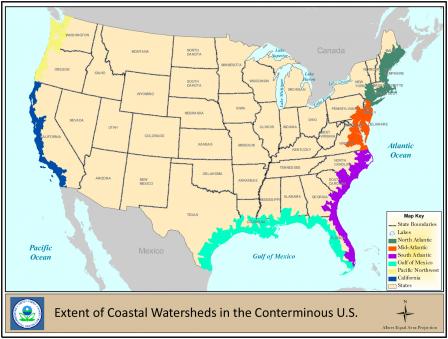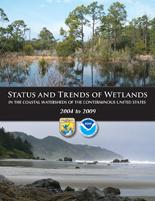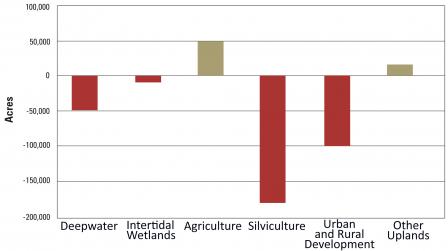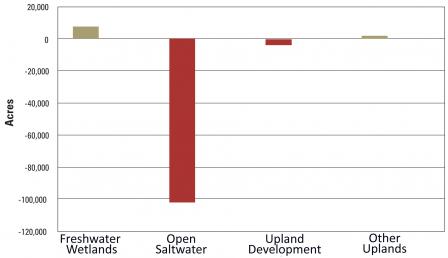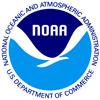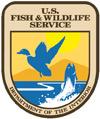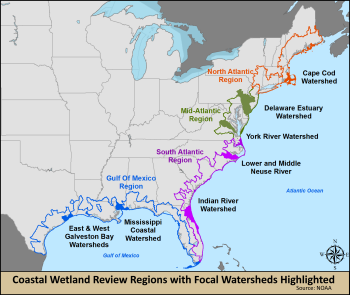Coastal Wetlands
About Coastal Wetlands
Despite their environmental and economic importance, coastal wetlands (wetlands located in coastal watersheds) in the eastern United States are being lost at twice the rate they are being restored. More focused protection strategies are required to reverse this trend.
- What are "coastal wetlands"?
- Why are coastal wetlands important?
- What is the rate of coastal wetlands loss?
- Why are coastal wetlands being lost?
- Protecting Wetlands Every Day!
What are "coastal wetlands?"
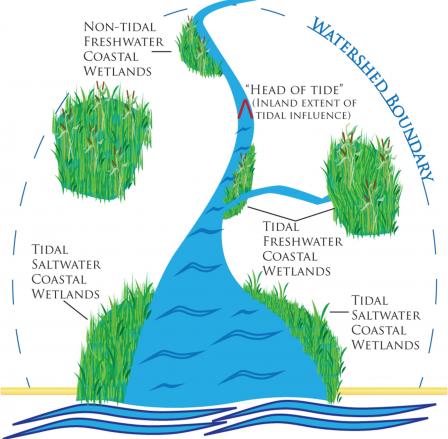 View Larger Diagram
View Larger Diagram
Coastal wetlands include saltwater and freshwater wetlands located within coastal watersheds — specifically USGS 8-digit hydrologic unit Exitwatersheds which drain into the Atlantic Ocean, Pacific Ocean, or Gulf of Mexico.
Wetland types found in coastal watersheds include salt marshes, bottomland hardwood swamps, fresh marshes, mangrove swamps, and shrubby depressions known in the southeast United States as "pocosins." Coastal wetlands cover about 40 million acres and make up 38 percent of the total wetland acreage in the conterminous United States. 81 percent of coastal wetlands in the conterminous United States are located in the southeast.
The diagram to the right illustrates the range of wetlands which can be found in a coastal watershed. These wetlands can be tidal or non-tidal, and freshwater or saltwater.
As seen on the map (left), coastal watersheds can extend many miles inland from the coast. The extent and condition of wetlands within a coastal watershed is both dependent on and influences the health of the surrounding watershed. Wetlands in coastal watersheds are experiencing disproportionate losses compared to wetlands in the rest of the country, making them particularly important areas for protection.
More information about wetlands can be found on the EPA Wetlands page.
Why are coastal wetlands important?
Coastal habitats provide ecosystem services essential to people and the environment. These services are valued at billions of dollars.1
Services provided by coastal wetlands include:
- Flood Protection: Coastal wetlands protect upland areas, including valuable residential and commercial property, from flooding due to sea level rise and storms.2
- Erosion Control: Coastal wetlands can prevent coastline erosion due to their ability to absorb the energy created by ocean currents which would otherwise degrade a shoreline and associated development.3
- Wildlife Food & Habitat: Coastal wetlands provide habitat for many federally threatened and endangered species, including Whooping Crane, Louisiana Black Bear and Florida Panther.4 Two of North America's migratory bird flyways pass over the Pacific and Atlantic coasts, where coastal wetlands provide temporary habitat to waterfowl and shorebirds.
- Commercial Fisheries: Over 50 percent of commercial fish and shellfish species in the Southeastern United States rely on coastal wetlands. 5
- Water Quality: Wetlands filter chemicals and sediment out of water before it is discharged into the ocean.3
- Recreation: Recreational opportunities in coastal wetlands include canoeing, kayaking, wildlife viewing and photography, recreational fishing and hunting.
- Carbon Sequestration: Certain coastal wetland ecosystems (such as salt marshes and mangroves) can sequester and store large amounts of carbon due to their rapid growth rates and slow decomposition rates.6
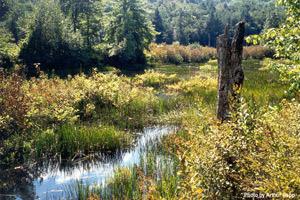
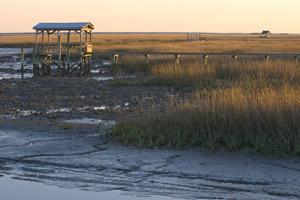
Coastal watersheds contain both freshwater (left) and saltwater (right) wetlands.
What is the rate of coastal wetland loss?
In the coastal watersheds of the Atlantic, Pacific, the Gulf of Mexico and the Great Lakes, wetlands were lost at an average rate of about 80,000 acres per year between 2004 and 2009.
Coastal wetland acreage trends are documented in the Status and Trends of Wetlands in the Coastal Watersheds of the Conterminous United States (PDF)(58 pp, 12 MB, About PDF) report by the U.S. Fish & Wildlife Service (FWS) and the National Oceanic and Atmospheric Administration's National Marine Fisheries Service. This analysis concluded that more than 80,000 acres of coastal wetlands are being lost on average each year, up from about 59,000 acres lost per year in the previous study covering 1998 to 2004. A majority of this loss occurred in freshwater wetlands.
Why are coastal wetlands being lost?
Coastal wetland losses occur as a result of both human activity and natural processes.
Human Activity: Human activities which may lead to losses of coastal wetlands include urban and rural development, agriculture, and silviculture. These land use changes can also indirectly impact nearby wetlands by altering hydrology through increased runoff or water withdrawals in the watershed. Most of this loss occurs in freshwater wetlands. Over half of the U.S. population lives in coastal counties, intensifying the stress on coastal wetlands relative to inland areas.7
Natural Processes: Coastal wetlands, especially estuarine and marine wetlands, are naturally altered by high energy events such as erosion and inundation from sea level rise and storms. The impacts of these processes may be magnified by climate change and shoreline armoring. Estuarine wetlands typically protect the coastline from erosion and flooding, but if sea level increases and development prevents inland migration of wetlands, more wetlands will be converted to open water.
Freshwater Wetlands
Saltwater Wetlands
Wetland losses and gains and the resulting changes in land cover between 2004 and 2009 in freshwater (top) and saltwater (bottom) wetlands. Loss or conversion occurred in 265,723 acres of freshwater wetlands and 94,999 acres of saltwater wetlands. Based on information from Status & Trends of Wetlands in the Coastal Watersheds of the Conterminous United States 2004 to 2009.
Protecting Wetlands Every Day!
We can make decisions in our everyday lives which help preserve coastal wetland area and maintain their ecological integrity.
- Participate in programs that help protect and restore wetlands. Contact local, state, or federal agencies, community groups, environmental organizations and other non-government organizations. See American Wetlands Month events.
- Report illegal actions such as unauthorized wetland fill or dredging activities to government authorities, such as the U.S. Environmental Protection Agency or the U.S. Army Corps of Engineers.
- Pick up litter and dispose in appropriate trash containers. Keep surface areas that wash into storm drains clean from pet waste, toxic chemicals, fertilizers and motor oil, which can eventually reach and impair our wetlands.
- Use native species when planting trees, shrubs and flowers to preserve the ecological balance of local wetlands.
- Use "living shoreline" techniques that make use of plant roots to stabilize soil if you own waterfront property and your shoreline or river bank needs to be stabilized.
- Avoid wetlands if you are expanding your house or installing a shed.
- Use phosphate-free laundry and dishwasher detergents. Phosphates encourage algae growth, which can suffocate aquatic life.
- Use paper and recycled products made from unbleached paper. Bleached paper contains toxic chemicals that can contaminate water.
- Use non-toxic products for household cleaning and lawn and garden care. Never spray lawn and garden chemicals outside on a windy day or on a day that it might rain and wash the chemicals into waterways.
- Enjoy the scenic and recreational opportunities coastal wetlands offer, while preserving their integrity for future generations by minimizing the use of heavy equipment and staying in designated visitor areas where available.
1 Pendleton, L. 2008. The Economic and Market Value of Coasts and Estuaries: What's at Stake? Restore America's Estuaries, Arlington, VA, 182 pp.
2 Costanza, R., O. Pérez-Maqueo, ML Martinez, P Sutton, SJ Anderson, K Mulder. 2008. The value of coastal wetlands for hurricane protection. Ambio 37(4): 241-248
3 Carter, V. 1997. Technical Aspects of Wetlands: Wetland Hydrology, Water Quality, and Associated Functions. United States Geological Survey Water Supply Paper 2425.
4 FWS. Endangered Species.
5 Martin, DM, T Morton, T Dobrzynski, & B. Valentine. 1996. Estuaries on the Edge: The Vital Link Between Land and Sea. A Report by American Oceans Campaign.
6 NOAA National Marine Fisheries Service. Coastal Blue Carbon
7 NOAA National Ocean Service. 2004. Population Trends Along the Coastal United States: 1980-2008
Coastal Wetlands Initiative
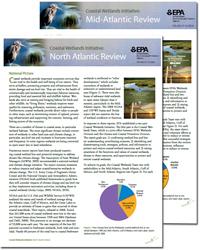 Read the Coastal Wetland Reviews
Read the Coastal Wetland Reviews
The Coastal Wetlands Initiative was established by the EPA in response to the loss of coastal wetland acreage identified through the U.S. Fish & Wildlife Service's and National Oceanic and Atmospheric Administration - National Marine Fisheries Service's Status & Trends of Wetlands in the Coastal Watersheds of the Eastern United States (PDF) (36 pp, 8.7 MB) . Coastal wetlands in the eastern United States were lost at an average rate of 59,000 acres per year between 1998 and 2004, even while inland wetlands acreage across the United States was increasing. The initiative addresses the need to enhance conservation of coastal wetlands.
Partnerships
EPA works on the Coastal Wetlands Initiative in partnership with a number of federal agencies involved in coastal wetlands conservation. Agencies in the Interagency Coastal Wetlands Workgroup include:
Goals
The ultimate goal of the Coastal Wetlands Initiative is to reduce and reverse the trend of coastal wetland loss. The immediate goals of the initiative are:
- To better understand the underlying causes of wetland loss in coastal watersheds and contributing stressors;
- To recommend new or revised policies and programs to protect and restore wetlands in coastal watersheds;
- To identify and disseminate tools, strategies, policies and information to protect and restore wetlands in coastal watersheds; and
- To create public understanding of the functions and values of coastal wetlands and the threats they are facing, and to build support for coastal wetland protection and restoration.
Activities
Coastal Wetland Reviews The Interagency Coastal Wetlands Workgroup organized seven Coastal Wetland Review (CWR) meetings with stakeholders in coastal watersheds throughout the Mid-Atlantic, South Atlantic, North Atlantic, and Gulf of Mexico regions1 to collect information regarding stressors on coastal wetlands, local protection strategies and key gaps that, if addressed, could help reverse the trend of wetland loss. The purpose of the CWRs is to facilitate dialogue among stakeholders who share a vested interest in coastal wetland and resource protection and identify ways local, regional and national efforts to stem coastal wetland losses can be made increasingly effective.
The information contained in the four CWR reports is based on existing data in combination with the informed opinions and observations of meeting participants. This information should not be considered a perfect nor comprehensive presentation of issues within the region or within specific focal watersheds. Instead, it should be considered a baseline reconnaissance to build upon as EPA and its partners continue efforts to better protect coastal wetlands.
The Managing Stressors page summarizes the findings from these review meetings.
1 Due to limited resources, the West coast could not be included in this study.
Managing Stressors
Management tools and strategies identified through the Coastal Wetlands Initiative can be found here, to be used by resource managers and other stakeholders.
Coastal Wetland Review Strategies
This site compiles the management tools and strategies highlighted by the Coastal Wetland Review participants, and identifies additional resources which can be used to address stressors of concern. While each region has its own characteristic array of coastal wetland stressors, many management strategies can be transferred to areas experiencing similar issues. These tools and strategies address coastal wetland loss due to stressors such as agriculture, climate change, development, hydrologic modifications, invasive species and silviculture.

"Living Shorelines," a strategy highlighted in several Coastal Wetland Review areas, use natural features to stabilize coastlines (Source: Virginia Institute of Marine Science Exit)
Tools and Links
Tools and Resources
The following are a sample of toolkits designed to deal with various issues relevant to coastal wetlands. Protection strategies for individual wetland stressors identified in the Coastal Wetland Reviews can be found under Managing Stressors.
- Association of State Wetland Managers Wetlands and Watersheds Protection Toolkit Exit: Materials to help local governments incorporate wetland resource management into municipal planning.
- Environmental Law Institute Wetlands Newsletter Exit: Current news on wetlands policy, regulation, science and management.
- EPA Climate Ready Estuaries | Coastal Adaptation Toolkit: Information and resources about climate change and climate change adaption.
- EPA Watershed Academy: Educational modules about a variety of watershed issues.
- Federal Highway Administration Environmental Review Toolkit | Wetlands and Aquatic Ecosystems: Tools and information to avoid, minimize, and mitigate damage to wetlands, watersheds and coastlines as a result of transportation projects.
- NOAA Coastal Services Center: Technology, information and management strategies to help state and local government with coastal issues.
- NOAA Coastal & Waterfront Smart Growth: Guidance on the elements of Smart Growth and tools for implementation in coastal and waterfront communities.
- Sea Level Rise Affecting Marshes Model Exit: Visualization of areas of sea level rise inundation.
- Virginia Institute of Marine Science Exit: Information and tools about coastal ocean and estuarine science.
More Information

EPA:
National Oceanic & Atmospheric Administration:
U. S. Army Corps of Engineers:
U.S. Fish & Wildlife Service:
U.S. Geological Survey:
U.S. Department of Agriculture's Natural Resources Conservation Service:

